Your Sugar Detox Timeline Day by Day
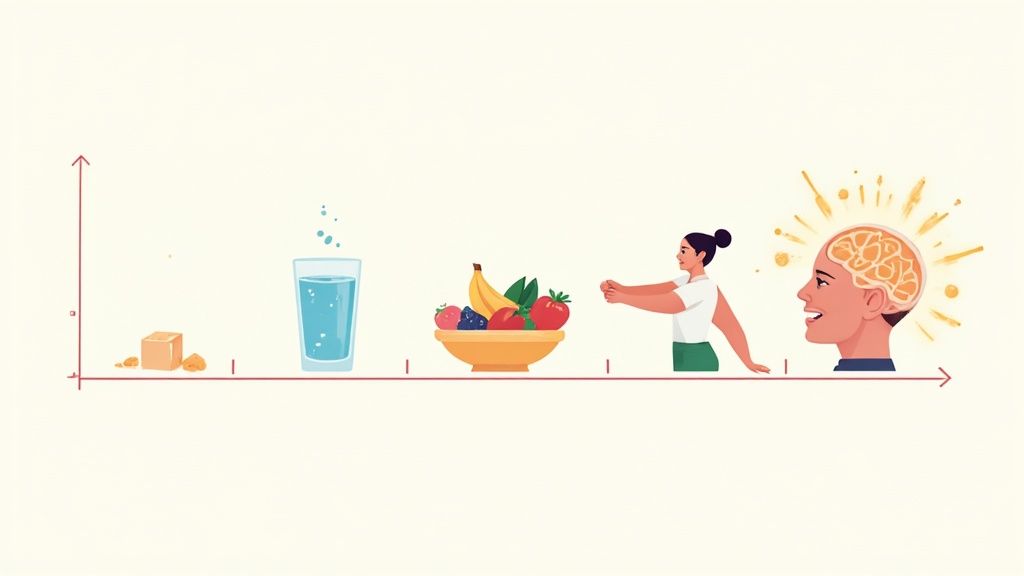
Let's be honest—the first three days of cutting out sugar can be tough. Really tough. This is when the cravings hit hardest and you might even get a headache or feel grumpy. But if you know what to expect and how to handle it, you can absolutely get through it. This initial hurdle is the most intense part of the sugar detox timeline, and clearing it sets you up for success.
The First 72 Hours: What To Expect
I won't sugarcoat it (pun intended): these first 72 hours are often a real battle. Your body has gotten used to a steady stream of sugar for quick energy and those little mood boosts, so when you suddenly cut off the supply, it has to scramble to recalibrate. This is where you'll feel the withdrawal symptoms most intensely, both physically and mentally.
Think of it like your brain is being rewired. For so long, it's been in a feedback loop where sugar triggers a dopamine release, making you feel good and want more. Now, you're breaking that cycle. It’s a shock to the system, but it’s a necessary one.
To help you get through it, here's a quick rundown of what you might feel during those first few days and, more importantly, what you can do about it.
Your First 3 Days: What to Expect and How to Cope
| Day | Common Symptoms | Coping Strategy |
|---|---|---|
| Day 1 | Intense cravings, especially in the afternoon. Mild headaches may start. You might feel irritable or anxious. | Drink lots of water. Keep protein-rich snacks like a handful of almonds or a hard-boiled egg ready to stabilize blood sugar. |
| Day 2 | Headaches can become more pronounced. Brain fog is common, making it hard to focus. Cravings are still very strong. | Go for a short, 15-minute walk to boost endorphins. Add a squeeze of lemon to your water to make it more interesting and help with cravings. |
| Day 3 | Often the peak of withdrawal. You might feel fatigued, moody, and still have strong cravings, but they may start to feel less urgent. | Eat a meal with healthy fats, protein, and fiber (like salmon with avocado and broccoli). This keeps you full and your energy levels even. Avoid strenuous workouts; stick to gentle movement. |
By Day 4, many people start to feel the fog lifting. The key is to be prepared and not just try to "white-knuckle" it.
Navigating The Initial Symptoms
During these first few days, a few common complaints always pop up. Headaches are a big one, often caused by your body adjusting to different hormone levels and even slight dehydration. You might also feel foggy and short-tempered as your blood sugar fluctuates and your brain screams for its usual quick fix.
"Withdrawal symptoms from sugar can stem from dopamine deficiency in the brain. This deficiency can be temporarily relieved by eating more sugar, which is why cravings feel so powerful. Your brain is essentially trying to over-ride your self-control mechanisms."
The best way to get through this is to be proactive, not reactive. Here’s what works for my clients every time:
- Hydrate, Hydrate, Hydrate: Seriously, drink more water than you think you need. A lot of the time, a nagging headache is just your body asking for water, and a detox can dehydrate you more easily.
- Lean on Protein and Healthy Fats: Don't let yourself get hungry. Keep almonds, avocado slices, or cheese sticks on hand. These foods give you steady energy, which helps smooth out the blood sugar rollercoaster that drives cravings.
- Move Your Body Gently: You don't need to run a marathon. Just a quick walk around the block can boost endorphins, clear your head, and lift your mood far better than a candy bar ever could.
If you want a more detailed plan, our sugar detox for beginners guide has even more tips to help you start strong.
This chart gives you a great visual of the journey, from the peak of cravings in the beginning to feeling much more stable by the end of the first month.
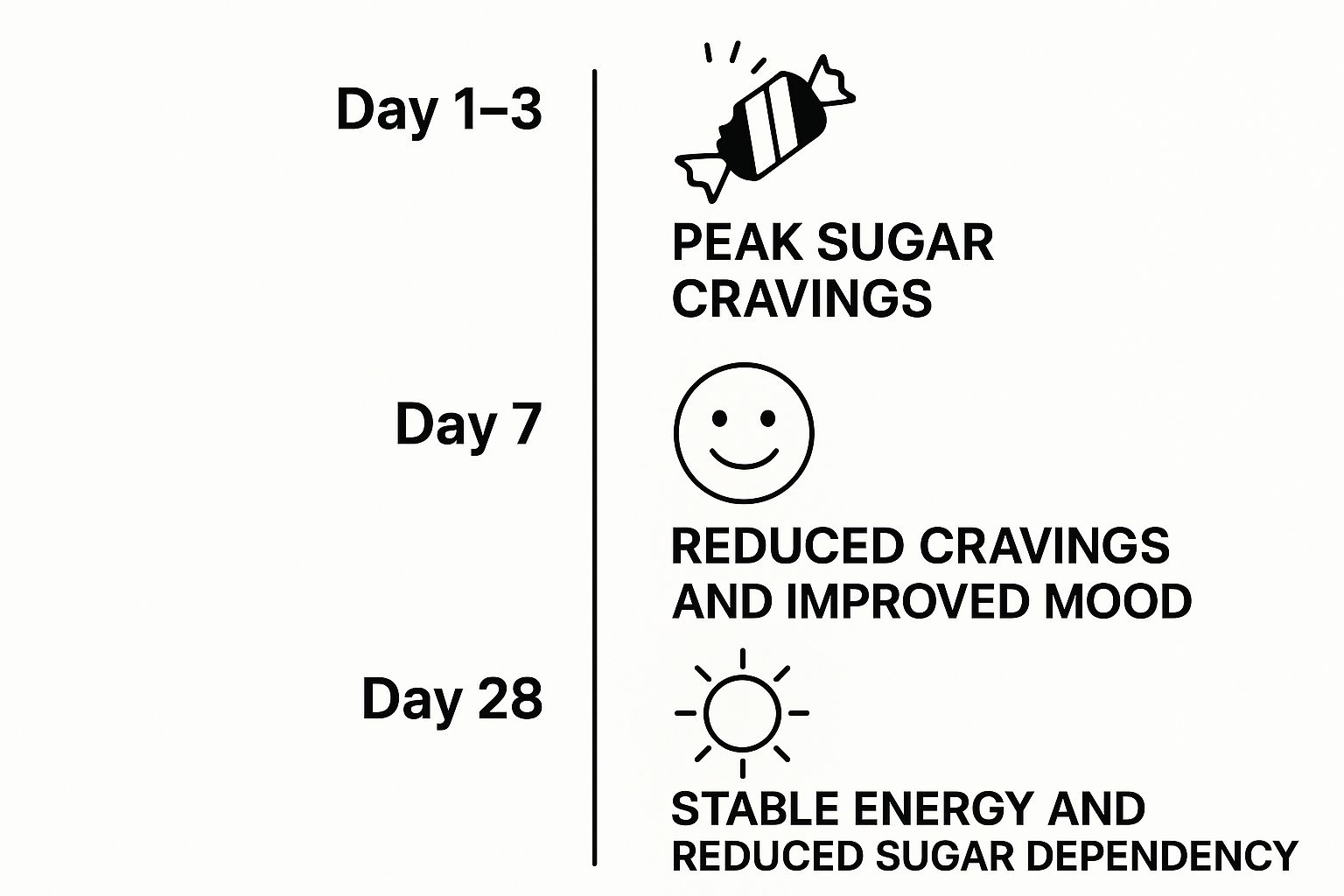
As you can see, while the first few days are the toughest, things start looking up pretty quickly. By the end of week one, your mood and cravings are already much more manageable.
Real-World Scenarios and How To Handle Them
Let’s play out a common scene. It’s 3 PM, you’re in a boring meeting, and a craving for a soda or a cookie hits you like a ton of bricks. Your focus is gone, and you can feel yourself getting annoyed at everything. What’s the move?
Instead of getting into a mental wrestling match with the craving, have a pre-planned escape route. Step out for a "restroom break" and chug a big glass of cold water. Then, eat the small bag of nuts you packed specifically for this moment. That one-two punch of hydration and protein is often all it takes to shut the craving down and get your head back in the game.
Preparation is everything. Those first 72 hours will absolutely test your willpower, but they don't last forever. Once you understand why you're feeling what you're feeling and have a few simple tools ready, you can get through this critical first phase and come out the other side.
Getting Through Your First Week Without Sugar
So, you’ve survived the first few days. That’s a huge accomplishment! Once you get past that initial 72-hour peak, things start to shift. The intense, almost primal physical withdrawal symptoms from your sugar detox timeline usually begin to quiet down. Now, it's less about the physical fight and more about the mental game.
Around day four or five, something interesting happens. You might notice the desperate, sharp cravings have vanished, but you feel… a little flat. Don't worry, this is totally normal. Your body is learning to burn protein and healthy fats for fuel instead of constantly screaming for a quick sugar hit. This process of becoming metabolically flexible is a massive win, even if it doesn't feel like a party just yet.
Navigating New Feelings and Social Minefields
As your body adjusts, you'll need some new tricks up your sleeve to feel satisfied and stay the course, especially as you head into your first weekend. This is where a lot of people trip up—not because of a sudden, overwhelming craving, but from social pressure or just not being prepared.
One of the first questions I always get is about fruit. After being super strict for the first few days, you can start reintroducing a small serving of low-glycemic fruit. Think a small handful of berries or a crisp green apple. This can be a game-changer for satisfying that desire for something sweet without derailing all your hard work. Since you're eating the whole food, the fiber helps slow down how your body absorbs the natural sugar.
I love when people hit this turning point in the first week. It’s when you stop missing sugar and start noticing it everywhere else. Suddenly, you can taste the subtle sweetness in foods like carrots or sweet potatoes that was always there, just hidden. That’s your taste buds waking up.
To keep meals from feeling like a punishment, you have to get creative with flavor and texture.
- Embrace Healthy Fats: Make sure you're adding avocado, nuts, seeds, or a good drizzle of olive oil to your meals. Fat is what tells your brain you're full and satisfied, and it keeps you that way for hours.
- Roast Your Veggies: This is my secret weapon. Roasting vegetables like broccoli, cauliflower, and Brussels sprouts caramelizes their natural sugars and gives them an amazing crispy texture. You won't even miss the junk.
- Lean on Herbs and Spices: Get friendly with garlic, onion, smoked paprika, cumin, and fresh herbs like cilantro or parsley. They can turn a simple plate of chicken and veggies into something you actually look forward to eating.
Tackling Your First Weekend
Your first sugar-free weekend can feel like the final boss battle of week one. A friend offers you a slice of birthday cake, or your family decides it's ice cream night. It’s coming, so be ready. Having a simple, polite "out" prepared makes all the difference.
Instead of a harsh "I can't, I'm on a detox," try something a little softer. "That looks incredible, but I'm trying to cut way back on sugar right now. I'll just stick with my coffee, thanks!" It’s firm but friendly, and it usually shuts down any further questions.
This first week is all about building a solid foundation of new habits. Focus on filling your plate with delicious, whole foods and have a plan for social events. If you can do that, you’ll cruise into week two feeling energized, proud, and completely in control.
Week Two: Finding Your New Normal
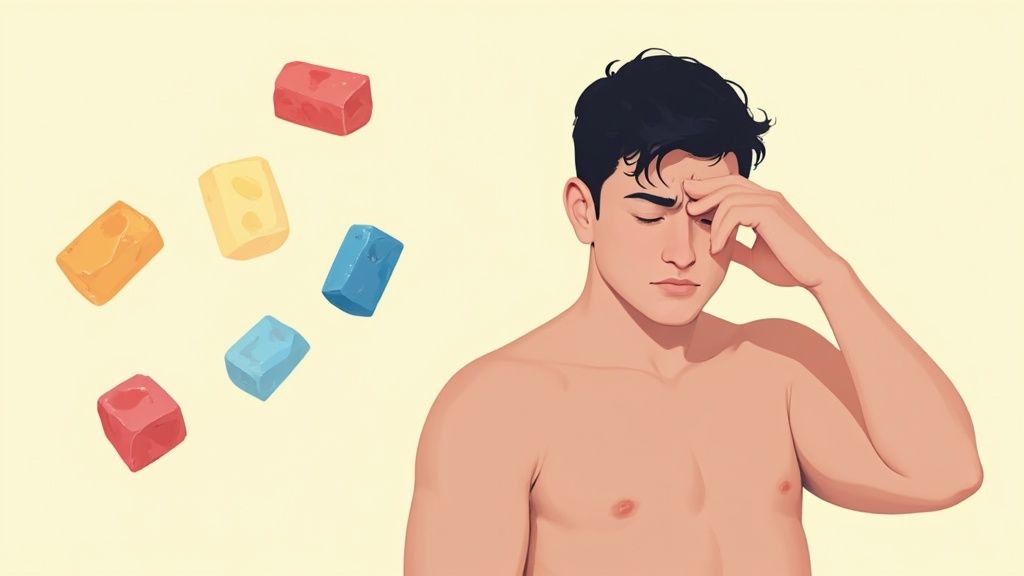
Alright, you made it through the first week. Take a moment to appreciate that, because the hardest part is likely behind you. As you step into week two of your sugar detox, you'll probably notice something incredible starting to happen: the fog begins to lift.
That constant, nagging battle for control that defined the first seven days starts to quiet down. In its place, you’ll find a sense of stability and clarity that might feel brand new. This is when the real magic begins, and you start to truly feel the benefits of your hard work.
What's happening on a biological level is that your brain's reward system is recalibrating. It's no longer being held hostage by those intense dopamine spikes from sugar. This neurological "reset" is the key to the amazing changes you’ll experience between days 8 and 14.
Your Taste Buds Are Coming Back to Life
One of the most profound and genuinely cool things that happens around now is that your taste buds wake up. Seriously. Foods that you might have dismissed as bland before suddenly have a complex, natural sweetness. A simple red bell pepper or a handful of raspberries will taste unbelievably vibrant.
This isn't just your imagination. Your palate is literally re-learning how to taste food without the overwhelming presence of processed sugar. You’re no longer chasing that artificial high, and instead, you’re starting to find real pleasure in the authentic flavors of whole foods. It’s a game-changer for making this stick.
This is the week you stop focusing on what you’re giving up and start getting excited about what you’re gaining. That mental shift is everything when it comes to turning a short-term detox into a lifestyle you actually enjoy.
With your body and mind finding a new rhythm, now is the perfect time to build some smart habits to carry you forward.
Building Habits That Actually Stick
The initial buzz of starting something new can fade, and this is often where willpower alone starts to fail. This is where you need to get strategic. It’s time to lock in the routines that will make this easy.
- Become a Label Detective: I can't stress this enough. Hidden sugars are lurking in places you'd never expect—salad dressings, "healthy" yogurts, pasta sauces, and even bacon. Make it a non-negotiable habit to scan ingredient lists for things like dextrose, malt syrup, or high-fructose corn syrup. Knowing what's in your food is your best defense.
- Meal Prep Is Your Secret Weapon: Decision fatigue is real. After a long day, the last thing you want is to figure out a healthy meal. Spend an hour on the weekend chopping veggies, cooking some protein, and portioning out snacks. Having go-to options ready and waiting is often the single thing that saves you from a moment of weakness.
- Flip Your Motivation Script: Stop thinking, "I can't have a cookie." Instead, focus on what's improving. Is your energy more consistent throughout the day? Are you sleeping more soundly? Does your skin look clearer? Tuning into these positive results is far more motivating than dwelling on restrictions.
Week two is about the transition from surviving to thriving. By leaning into these strategies, you're not just gritting your teeth through a detox. You're actively building a new foundation for a healthier relationship with food. You’re finding your new normal, and it feels pretty great.
Weeks Three and Four: Building Lasting Change
By the time you hit week three, you're in a completely different ballpark. The tough physical withdrawals are likely behind you, and you're stepping into a new phase. This is where you transition from just surviving the detox to building a lifestyle that will actually stick.
This is less about fighting off intense cravings and more about cementing the great habits you've already started. It’s also when many of the best benefits really start to shine through. People often notice their skin clearing up, sleep becoming deeper and more restorative, and a steady, reliable energy that lasts all day long. No more afternoon slumps.
From Survival to Sustainability
The main goal for these two weeks is simple: turn conscious, hard work into an effortless, unconscious habit. You're not just avoiding sugar anymore; you're actively creating a new way of eating that feels genuinely good. This is when you can start thinking about your long-term relationship with certain foods.
If you decide to reintroduce something—say, a small piece of high-quality dark chocolate or a special dessert on your birthday—you're doing it from a place of control, not compulsion. You might be shocked at how intensely sweet things taste now and how little it takes to feel satisfied. The key is to pay close attention to how your body responds without letting one treat send you spiraling back into old habits.
This phase is critical for solidifying the metabolic benefits you've earned. Your body is becoming much more efficient at regulating blood sugar on its own, which is a huge win for your long-term health.
Tackling Real-Life Challenges
Life doesn’t pause just because you’re on a health journey. You’ll have to navigate birthday parties, holidays, and dinners out. The great news is, you're now equipped to handle these situations without feeling overwhelmed or deprived.
Here’s a game plan that works for me when I’m eating out:
- Scout the menu online: I always look up the restaurant's menu before I go. I decide what I'm having ahead of time so I'm not tempted by last-minute, less-healthy choices when I'm hungry.
- Don't be afraid to ask: Politely request sauces on the side or ask for your protein to be grilled instead of fried. Most kitchens are happy to accommodate.
- Enjoy the people, not just the plate: The best part of dining out is the company. Shift your focus to the conversation and the experience itself.
It's also helpful to remember that your body is still adjusting. Some lingering issues like mild fatigue or irritability can pop up as part of the final stages. Understanding the full range of potential sugar detox side effects can be really reassuring during this time.
The metabolic shifts happening now are seriously impressive. Dietary studies have found that people who commit to a lower-sugar plan for a month or more can see their fasting insulin levels drop by up to 20%. This shows just how powerful and lasting the changes are when you push through to this stage. You can read more about these benefits in this report from the USDA.
By the end of week four, you haven't just finished a "detox"—you've kicked off a healthier, more vibrant way of life.
Why Your Detox Journey Is Unique
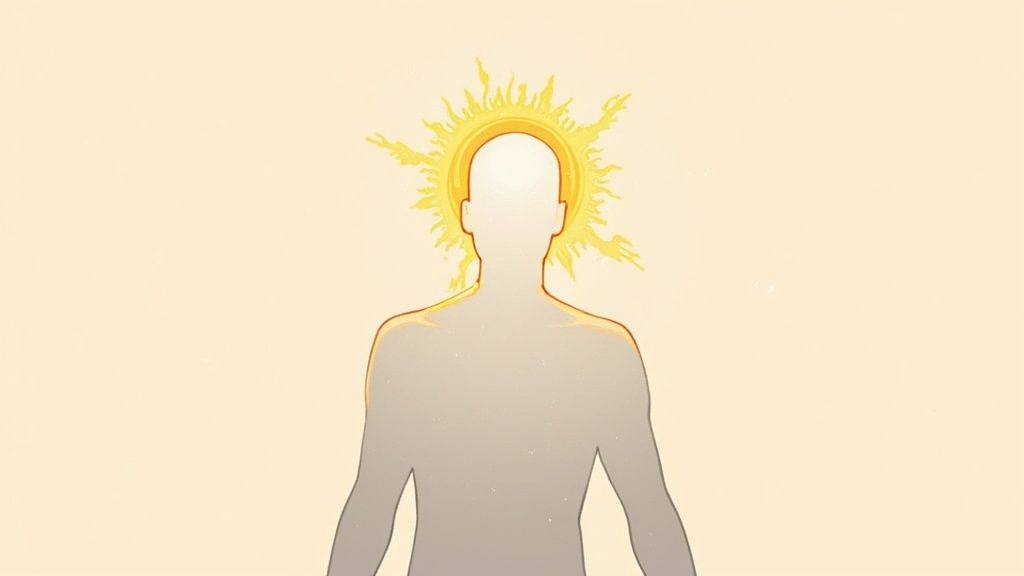
It’s so easy to look at a standard sugar detox timeline and feel like you’re failing if your experience doesn't line up perfectly. Maybe your friend’s cravings vanished in a week, but yours are still hanging on. Or perhaps you didn't get that promised burst of energy on day eight. I’m here to tell you: that's completely normal. This journey is yours, and yours alone.
Comparing your progress is like comparing apples and oranges. Your body, your history with food, and even where you live all have a say in how you feel when you cut out sugar. The key to staying motivated is to give yourself some grace and understand the variables at play.
The Personal Factors That Shape Your Timeline
Your starting point makes a huge difference. Someone who was downing sugary sodas and processed foods daily is naturally going to have a tougher withdrawal period than someone who only indulged in dessert on weekends.
Think of it like this: the more your brain got used to that sweet, sweet dopamine rush from sugar, the louder it’s going to complain when you take it away. This has nothing to do with willpower and everything to do with brain chemistry.
Several things will influence how intense your symptoms are and how long they last:
- Your Old Diet: How much sugar were you really eating? The higher your daily intake was, the bigger the adjustment your body has to make.
- Your Metabolism: We all process energy differently. Your age, how active you are, and even your muscle mass all affect how quickly your body learns to burn fat and protein for fuel instead of constantly looking for its next sugar hit.
- Genetics and Overall Health: Your unique genetic makeup and any underlying health conditions can absolutely play a role in how you feel during withdrawal.
It's so important to own your timeline without judging it. Whether it's a smooth ride or a rollercoaster, your experience is valid. Remember, the goal is progress, not perfection.
How Culture and Environment Play a Role
It's not just about your biology, either. Your environment has a massive impact. The culture you live in and the food that surrounds you can make this process easier or much, much harder. For instance, how much sugar people eat varies wildly around the world, which shapes how different populations experience a detox.
In North America, for example, sugar is tucked into almost every processed food imaginable. This means avoiding it takes a lot of conscious effort and label-reading. Someone living there might face more social hurdles than a person in a country where the diet is naturally based on whole, unprocessed foods.
While global sugar consumption is rising, projections show that intake in regions like Asia and Africa is expected to stay below the world average. If you're curious about these global trends, the OECD-FAO Agricultural Outlook offers some fascinating insights.
Ultimately, getting a handle on these personal and environmental factors gives you context. It helps you set realistic expectations for your sugar detox timeline and lets you move forward with confidence, knowing that your journey is perfectly, uniquely yours.
Common Sugar Detox Questions Answered
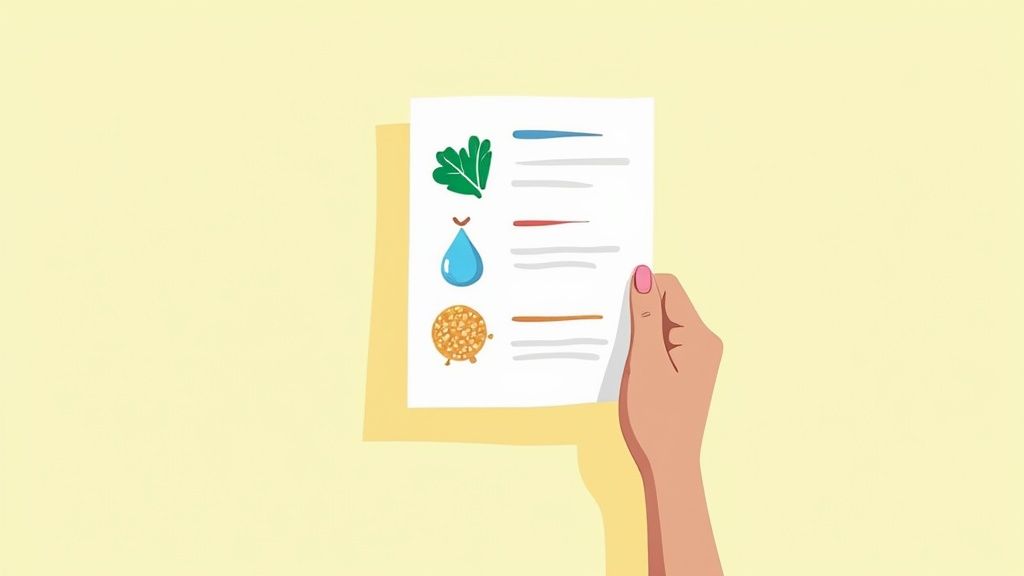
As you make your way through your sugar detox timeline, you're bound to run into some practical questions. It happens to everyone. Having solid, go-to answers ready can be the thing that keeps you from getting derailed. Let's tackle some of the most common hurdles you might face.
What Are the Best Go-To Snacks?
When a craving ambushes you, being prepared is everything. The last thing you want is to get "hangry"—that’s a surefire way to end up grabbing the first sugary thing in sight. The trick is to have smart snacks on hand that keep your blood sugar stable and help you feel satisfied.
Your best bet is to reach for snacks high in protein, healthy fats, and fiber. These nutrients give you that slow, steady burn of energy, completely avoiding the spike-and-crash roller coaster that sugar puts you on.
Here are a few of my favorites that I always recommend:
- A small handful of almonds or walnuts: They're a powerhouse of healthy fats and protein.
- Half an avocado with a sprinkle of sea salt: Incredibly satisfying and packed with good-for-you fats.
- A hard-boiled egg: A perfect, portable protein boost you can take anywhere.
- Celery sticks with nut butter: You get a great crunch and a creamy texture that can kill multiple cravings at once.
- A handful of olives: A fantastic savory option that nips cravings for salty, processed junk food in the bud.
Can I Drink Alcohol During a Detox?
This is a really common question, and honestly, it’s a tricky one. The short answer? It's best to skip it, especially in those first couple of weeks.
Your body treats alcohol like a toxin, and it metabolizes it in a way that's very similar to sugar. Just one drink can spike your blood sugar, kickstart cravings, and, let's be real, lower your inhibitions. Suddenly, saying no to that dessert menu becomes ten times harder.
Your brain adjusts to the depressant effect of substances like alcohol. When you suddenly stop, your brain can become overstimulated, leading to withdrawal symptoms. Adding alcohol during a sugar detox can confuse this recalibration process.
If you find yourself in a social situation where everyone's drinking, just order sparkling water with a lime. It looks the part, helps you feel included, and keeps you on track without a second thought.
What If I Have a Relapse?
First things first: take a deep breath. A slip-up is not a failure. It’s just a learning opportunity. It doesn't undo all the amazing work you've already put in. The single most important thing you can do is get right back on the horse with your very next meal.
Don't let yourself fall into that all-or-nothing mindset. Instead of thinking, "Well, I blew it, I might as well eat the entire cake," just acknowledge what happened and move on. Drink a big glass of water, and make sure your next meal is loaded with protein and veggies. Getting back to your plan immediately is what really matters. For more compassionate strategies, you can also explore our guide on how to stop sugar cravings for good.
Will I Actually Lose Weight?
Many people do lose weight when they cut sugar, but it’s not a given and shouldn't be your only motivation. When you quit sugar, you're cutting out a huge source of empty calories. This often reduces bloating and water retention, which can lead to a quick drop on the scale. It's a nice perk!
The real victories, however, go way beyond weight. You're building a healthier metabolism, stabilizing your energy levels, and lowering your risk for serious long-term health problems. Try to focus on these incredible non-scale victories. It’s a personal journey that can be made tougher by outside factors; a rising global sugar supply often lowers prices, which unfortunately encourages more consumption. You can learn more about these market dynamics in this Globenewswire report on the sugar market.